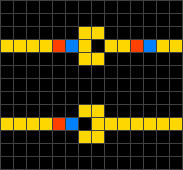For those of you who don't know what it is, it is a cellular automaton, similar to the game of life.
The difference is in the rules.
There are four states:
empty - always stays empty
copper - stays as copper unless there are 1 or 2 electron heads in the surrounding cells.
electron head - always turns into an electron tail
electron tail - always turns into copper
These simple rules allow for very complex circuits to be build. (Somebody even built an entire programmable computer with display which calculated prime numbers!)
Links:
Wikipedia
Wireworld computer (contains a java simulation of the final computer built, and explanations of how it all works!)
Collection of logical elements
A diode in wireworld:

Two clock generators and an XOR logical element:

Notice how when both wires are active, the output copper cell is surrounded by 3 electrons rather than 1 or 2, and so the current is not transmitted.
It is possible to create any logical element in wireworld.
Electrons are sent at regular intervals, and a missing electron represents a 0, while a present electron represents a 1.
Anyone ever come across this before? Got any new ideas for components?
You can download my simulator and editor I made in Dark GDK(Attached)
Controls:
1 - Set draw mode to clear
2 - Set draw mode to copper
3 - Set draw mode to electron head
4 - Set draw mode to electron tail
's' - Save to 'data.wi'
'l' - Load from 'data.wi'
Click to draw
Right-click and drag to select an area, dragging this selection will create copies of this area, but 'clear' is treated as transparent. Press delete to clear the selection, right-click to deselect all.
Press enter to begin simulation, and again to stop it.
Up/Down keys to change simulation speed.